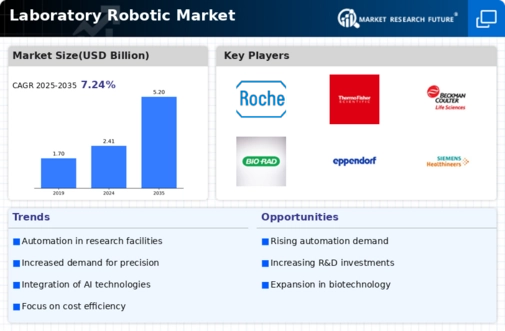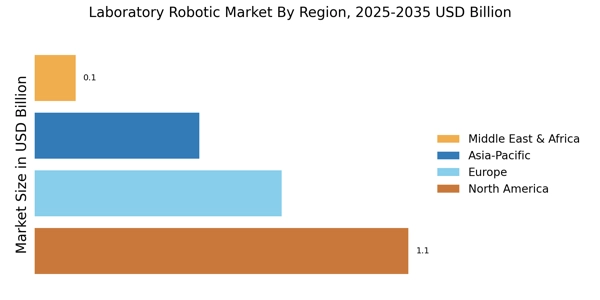Advancements in Robotic Technologies
Technological advancements play a crucial role in shaping the Laboratory Robotic Market. Innovations in artificial intelligence, machine learning, and sensor technologies are enhancing the capabilities of laboratory robots. These advancements enable robots to perform complex tasks with greater precision and adaptability. For instance, the introduction of vision systems allows robots to identify and manipulate samples more effectively. Market data suggests that the adoption of advanced robotic systems is expected to increase by over 15% in the coming years, as laboratories seek to improve efficiency and reduce human error. Consequently, the Laboratory Robotic Market is poised for growth, driven by the continuous evolution of robotic technologies that cater to diverse laboratory needs.
Rising Demand for Personalized Medicine
The shift towards personalized medicine is significantly impacting the Laboratory Robotic Market. As healthcare moves towards tailored treatments, laboratories are increasingly required to conduct complex analyses on a smaller scale. This demand necessitates the use of advanced robotic systems capable of handling diverse sample types and performing intricate assays. Market analysis suggests that the personalized medicine sector is projected to grow at a CAGR of 12% over the next several years, driving the need for automation in laboratories. Consequently, the Laboratory Robotic Market is likely to expand as laboratories invest in robotic solutions that facilitate the efficient processing of personalized medicine applications, thereby enhancing patient outcomes.
Growing Demand for High Throughput Screening
The Laboratory Robotic Market is experiencing a surge in demand for high throughput screening (HTS) technologies. This trend is primarily driven by the need for rapid and efficient drug discovery processes. Pharmaceutical companies are increasingly adopting laboratory robotics to automate repetitive tasks, thereby enhancing productivity and accuracy. According to recent data, the HTS market is projected to grow at a compound annual growth rate (CAGR) of approximately 10% over the next five years. This growth is indicative of the broader shift towards automation in laboratory settings, where the integration of robotics is seen as a pivotal factor in accelerating research timelines and reducing operational costs. As a result, the Laboratory Robotic Market is likely to witness significant advancements in robotic systems designed specifically for HTS applications.
Expansion of Research and Development Activities
The expansion of research and development (R&D) activities across various sectors is a key driver for the Laboratory Robotic Market. Increased funding for scientific research, particularly in biotechnology and pharmaceuticals, is leading to a higher demand for laboratory automation solutions. As organizations strive to accelerate their R&D processes, the integration of robotics becomes essential for improving workflow efficiency. Recent statistics indicate that R&D spending in the life sciences sector is expected to exceed USD 200 billion by 2025. This influx of investment is likely to propel the Laboratory Robotic Market forward, as laboratories seek to adopt robotic systems that can streamline operations and enhance research capabilities.
Increased Focus on Laboratory Safety and Compliance
Safety and compliance are paramount in laboratory environments, significantly influencing the Laboratory Robotic Market. As regulations become more stringent, laboratories are compelled to adopt robotic solutions that minimize human exposure to hazardous materials. Automation not only enhances safety but also ensures compliance with industry standards. Data indicates that the market for laboratory automation solutions is expected to reach USD 5 billion by 2026, reflecting a growing emphasis on safety protocols. This trend is likely to drive the adoption of robotics in laboratories, as organizations prioritize the implementation of systems that enhance safety while maintaining operational efficiency. Thus, the Laboratory Robotic Market is likely to benefit from this heightened focus on safety and compliance.

















Leave a Comment